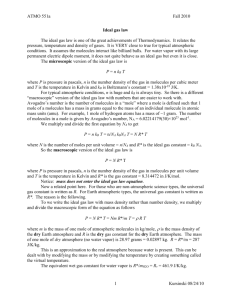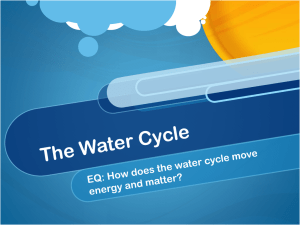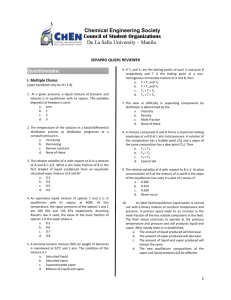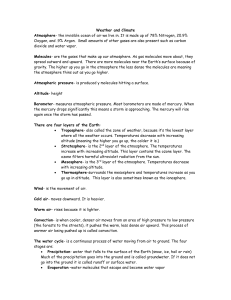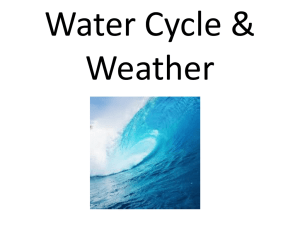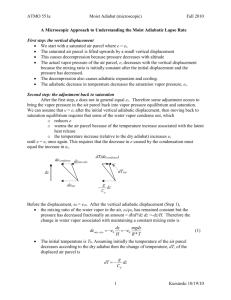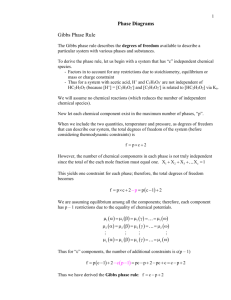Answers
advertisement
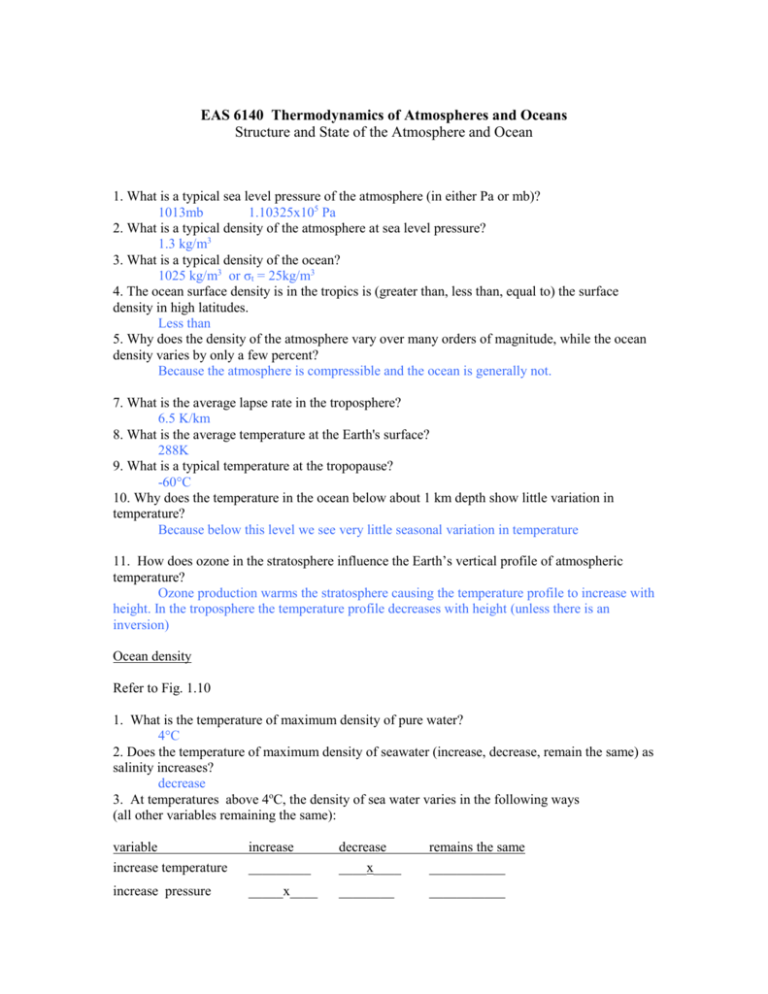
EAS 6140 Thermodynamics of Atmospheres and Oceans Structure and State of the Atmosphere and Ocean 1. What is a typical sea level pressure of the atmosphere (in either Pa or mb)? 1013mb 1.10325x105 Pa 2. What is a typical density of the atmosphere at sea level pressure? 1.3 kg/m3 3. What is a typical density of the ocean? 1025 kg/m3 or σt = 25kg/m3 4. The ocean surface density is in the tropics is (greater than, less than, equal to) the surface density in high latitudes. Less than 5. Why does the density of the atmosphere vary over many orders of magnitude, while the ocean density varies by only a few percent? Because the atmosphere is compressible and the ocean is generally not. 7. What is the average lapse rate in the troposphere? 6.5 K/km 8. What is the average temperature at the Earth's surface? 288K 9. What is a typical temperature at the tropopause? -60°C 10. Why does the temperature in the ocean below about 1 km depth show little variation in temperature? Because below this level we see very little seasonal variation in temperature 11. How does ozone in the stratosphere influence the Earth’s vertical profile of atmospheric temperature? Ozone production warms the stratosphere causing the temperature profile to increase with height. In the troposphere the temperature profile decreases with height (unless there is an inversion) Ocean density Refer to Fig. 1.10 1. What is the temperature of maximum density of pure water? 4°C 2. Does the temperature of maximum density of seawater (increase, decrease, remain the same) as salinity increases? decrease 3. At temperatures above 4oC, the density of sea water varies in the following ways (all other variables remaining the same): variable increase temperature increase _________ decrease ____x____ remains the same ___________ increase pressure _____x____ ________ ___________ increase salinity _____x____ ________ ___________ #4 is OPTIONAL 4. Go to the Interactive Ocean Density Calculator http://www.phys.ocean.dal.ca/~kelley/seawater/WaterProperties.html a) Use the default values. What is the surface density? 1027.40 kg/m3 b) After a rain storm, the surface is freshened and the salinity becomes 31. What is the surface density? 1024.29 kg/m3 c) At night, the ocean surface cools slightly, to 8oC. What is the surface density? 1027.73 kg/m3 Elementary kinetic theory (refer to section 1.6) 1. The pressure of ideal gas on the walls of a container varies in the following ways (all other variables remaining the same): Variable Incr. Speed of Molecules Incr. Mass of Molecules Incr. Vol. of Container Incr. Temperature Increase x x Decrease Remains the Same x x 2. If the speed of each molecule in an ideal gas were tripled, would the temperature also triple? Temperature and velocity are not directly proportional. If the velocity tripled the temperature would increase by a factor of 9. 3. If the temperature of an ideal gas doubled from 50 °C to 100 °C, does the average kinetic energy of the molecules double? No. It is important to remember that the kinetic energy of the gas would not double because we have to assess the changes in terms of absolute temperature. For example, this change is essentially analogous to a 323K to 373K change. This would not cause the KE to double. 4. Is it possible for both the pressure and volume of an ideal gas to change without causing the internal energy of the gas to change? Yes, because the change in KE is related to the change in temperature. As long as the change is isothermal in nature it is possible. 5. If the atoms in a container of helium gas have the same average speed as the atoms of a container of argon, which one has the higher temperature? If two atoms have the same speed but one has a heavier mass, the atom with the heavier mass will translate into more energy and a higher temperature. 6. Which, if either, contains a greater number of molecules, one mole of hydrogen or one mole of oxygen? Which, if either, has more mass? The number of molecules in a mole of hydrogen and a mole of oxygen is the same. This is 6.02x1023 Equation of state for mixture of ideal gases (refer to section 1.7) 2. The equation of state for an ideal gas can be written as pV=nR*T where p is pressure, V is volume, n is the number of moles, T is temperature, and R* is the universal gas constant. a) which variables are extensive? Volume Number of moles b) divide both sides of the equation by mass (m), thereby converting the two extensive variables to intensive variables. pV=nR*T m m c) Using the following definitions: Molecular weight: M=m/n Specific volume: v=V/m rewrite the original equation of state using only intensive variables. pV=R*T M d) The specific gas constant, R, is defined as R*/M. Rewrite the ideal gas law using intensive variables and the specific gas constant. (eq 1.12) pV=RT (Note R* represents universal gas const. R represents specific gas const) e) Estimate the specific gas constant for nitrogen. (molecular weight for N2 is 28 g/mole) R = R*/M = (8.314J/mole K )/(28g/mole)=296.93J/kgK f) For a mixture of ideal gases, an average specific gas constant can be defined as a massweighted mean of the gaseous constituents. Since the atmosphere is about 75% (by mass) nitrogen and oxygen is the next most abundant atmospheric gas (about 23% by mass), would the specific gas constant for the mixture of nitrogen and oxygen be greater or less than the value of R calculated for nitrogen? The specific gas constant for the mixture of all atmospheric gases except for water vapor is generally referred to as the "dry air" gas constant, Rd. R(O2) < R(N2) Equation of state for moist air g) Complications are introduced by the presence of water vapor, which has a variable amount. From Dalton's law of partial pressure, the equation of state can be written individually for each gas in a mixture. Write the equation of state for water vapor, using the notation e for water vapor partial pressure and the subscript v to denote vapor. pv = RT pev=RvT ev= RvT h) By combining the equations of state for the "dry air" gases with that for water vapor (see details in section 1.7), a gas constant for dry air plus water vapor (moist air) can be written R = Rd (1 + 0.608 qv) where qv is the specific humidity, defined as the fractional mass of water vapor. Write an equation of state for moist air, using the specific gas constant for moist air. ev= RvT ev = Rd (1 + 0.608 qv)T i) It is awkward to have a variable gas constant, so it is the convention among meteorologists to make the humidity adjustment to the temperature rather than to the gas constant. Thus we define a virtual temperature, Tv T v = 1 + 0.608 q v T (1.25) Rewrite the equation of state for moist air using virtual temperature (eq. 1.26) ev=RdTv j). Calculate the virtual temperature for the following conditions: a) T=303K, qv=0.025 b) T=243K, qv=0.003 a) Tv = (1 + (0.608*0.025))303 = 307.6056 b) Tv = (1 + (0.608*0.003))243 = 243.4432
